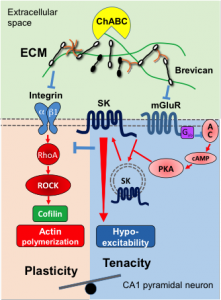TP6: Extracellular matrix-neuron-glia interactions during aging-associated cognitive decline and rejuvenation by ECM targeting (Alexander Dityatev)
 Neural ECM molecules derived from neurons and glial cells accumulate in the extracellular space and regulate synaptic plasticity, memory acquisition, cognitive flexibility and extinction of fear and drug memories (Dityatev et al., 2010; Senkov et al., 2014). Aging is associated with neuroinflammation and upregulation of ECM expression (Vegh et al., 2014b; von Bernhardi et al., 2015), however, a direct and drugable link between these two processes has not been established so far, although it is known that some neuroinflammatory cytokines, like TGF, can drive expression of ECM molecules and associated glycans following acute CNS injury (Smith and Strunz, 2005; Jin et al., 2009). We and others have shown that enzymatic digestion of elevated ECM with chondroitinase ABC (ChABC) improves synaptic transmission, plasticity, object recognition memory, and contextual fear in mouse models of dementia (Vegh et al., 2014a; Yang et al., 2015), and thus might counteract the aging and neuroinflammation-induced cognitive decline. Our data indicate that global removal of ECM with ChABC triggers multiple, partially antagonistic, processes in the hippocampus, such as an increase in excitability and decrease in excitatory input to fast-spiking parvalbumin (PV)-expressing interneurons, a decrease in excitability of CA1 pyramidal cells due to increase in cell surface small-conductance Ca2+-dependent K+ (SK) channels, as well as upregulation in signaling through b1 integrin-RhoA-ROCK pathway. It is critical to elucidate synaptic mechanisms triggered by upregulation of ECM in aged brains.
Neural ECM molecules derived from neurons and glial cells accumulate in the extracellular space and regulate synaptic plasticity, memory acquisition, cognitive flexibility and extinction of fear and drug memories (Dityatev et al., 2010; Senkov et al., 2014). Aging is associated with neuroinflammation and upregulation of ECM expression (Vegh et al., 2014b; von Bernhardi et al., 2015), however, a direct and drugable link between these two processes has not been established so far, although it is known that some neuroinflammatory cytokines, like TGF, can drive expression of ECM molecules and associated glycans following acute CNS injury (Smith and Strunz, 2005; Jin et al., 2009). We and others have shown that enzymatic digestion of elevated ECM with chondroitinase ABC (ChABC) improves synaptic transmission, plasticity, object recognition memory, and contextual fear in mouse models of dementia (Vegh et al., 2014a; Yang et al., 2015), and thus might counteract the aging and neuroinflammation-induced cognitive decline. Our data indicate that global removal of ECM with ChABC triggers multiple, partially antagonistic, processes in the hippocampus, such as an increase in excitability and decrease in excitatory input to fast-spiking parvalbumin (PV)-expressing interneurons, a decrease in excitability of CA1 pyramidal cells due to increase in cell surface small-conductance Ca2+-dependent K+ (SK) channels, as well as upregulation in signaling through b1 integrin-RhoA-ROCK pathway. It is critical to elucidate synaptic mechanisms triggered by upregulation of ECM in aged brains.
Hypothesis: Neuroinflammation elevates expression of the ECM molecules during aging and through this mechanism hinders hippocampal synaptic plasticity and learning. Our Aims:
- To dissect the impact of ECM upregulation on synaptic plasticity in young adult mice.
- To dissect the underlying mechanisms.
- To identify ECM molecule(s) and cell type(s), which attenuation may be beneficial for brain rejuvenation in aged mice, i.e. for restoration of synaptic plasticity and cognitive functions.
- To study the effects of anti-inflammatory drugs on changes in ECM expression and synaptic plasticity in aged mice.
Two signaling pathways controlled by ChABC-sensitive ECM.
Collaborations: TP2 Stork (behavioral analysis, b1 integrin functions in aged / ECM overexpressing mice), TP5 Dunay (anti-inflammatory drug effects: Flow cytometric and functional analysis of microglia), TP1/9 Dieterich (astroglia proteome, ECM composition and signaling via mechano-receptors), TP8 Gundelfinger/Seidenbecher and TP3/4 Kreutz (molecular mechanisms linking neuroinflammation, ECM and synaptic functions). We are maintaining and providing aging C57BL6J mice to the SynAGE consortium.

